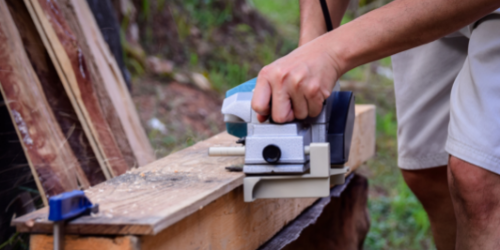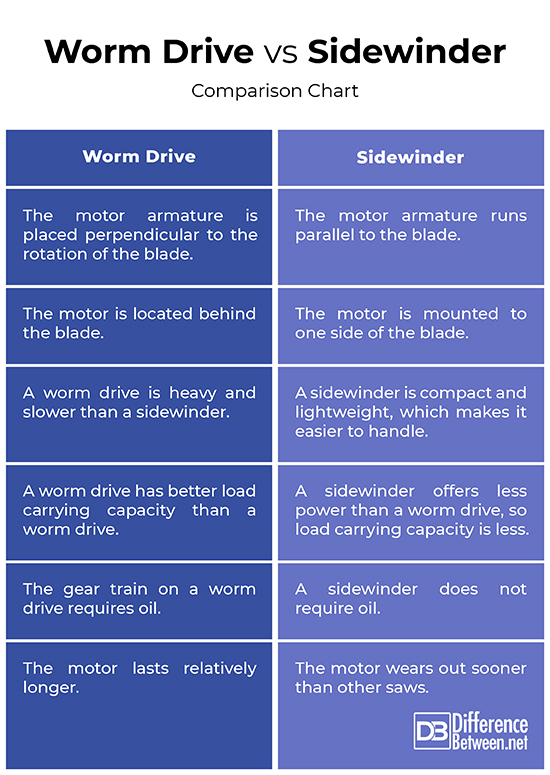Difference Between Worm Drive and Sidewinder
When it comes to cutting wood, there are two main power tools used – the circular saw and the sabre saw. Circular saws are used for almost 99 percent of the cutting on framing jobs. Sabre saws are used for notching, curve cutting, and making irregular holes. In terms of design, circular saws come in two types – worm drives and sidewinders (sometimes called spur gears).

What is Worm Drive?
Worm Drive (or Worm Gear) is a staggered shaft gear arrangement in which a worm gear in the shaft has a screw type thread and the power is transferred from one shaft to another, with each gear set at 90 degrees. A worm gear combines features of both a conventional gear drive and a power screw. The shafts are perpendicular to each other and do not intersect each other. In a worm gear assembly, you can see a gear is connected to an input shaft and the gear is nothing but a screw. As the screw rotates, it turns the gear with which it has been meshed which in turn is connected to an output shaft. An electric motor powers the worm which rotates against the worm wheel, providing high reduction ratios and correspondingly high torque.

What is Sidewinder?
A sidewinder circular saw, as the name suggests, is a power tool with the motor mounted off to one side of the saw, which directly turns the shaft that turns it around. Also known as in-line circular saws, sidewinders use motor that runs parallel to the blade which means the blade spins much faster, typically around 6,000 rpm. The motor position makes it fairly compact and lightweight. For the most part, a sidewinder has a blade on the right, as opposed to a worm drive, where the blade is on the left. They are commonly used to cut through masonry, wood, metal, and plastic for home improvement projects.
Difference between Worm Drive and Sidewinder
Motor Placement
– Both the circular saws look very different and that difference is mostly because of the position of the motor. A sidewinder uses a motor which is technically called a spur gear. The motor armature runs parallel to the blade and the motor is mounted to one side of the blade, which directly turns the shaft. On a worm drive, the motor sits behind the blade and the armature is placed perpendicular to the rotation of the blade.
Blade Orientation
– Perhaps for the most part, a sidewinder circular saw has a right-side blade placement, but many manufacturers today produce circular saws with a left-side blade placement. A worm drive, on the other hand, has the blade to the left side. So, depending on whether you’re left handed or right handed, it will mostly affect your sightline to the blade and how you’re going to use the tool.
Handling
– A sidewinder is compact and lightweight, which makes it easier to handle, especially when you’re working overhead. Also, the blade placement ensures that both hands are at a safe distance from the cut. A worm drive has its motor mounted to the rear of the blade, which results in less speed but more torque. Also, the blade is on the left hand side, which places the majority of the motor weight on the right, making it easier to follow the cut line, thanks to the improved sightline. However, worm drives are heavy and slower.
Worm Drive vs. Sidewinder: Comparison Chart

Summary of Worm Drive vs. Sidewinder
While worm drives, in regard to design, are used in a wide range of construction works, the sidewinders are light and generally easier to handle, making a better choice for fine work. A worm drive is heavy and slower, but it has better load carrying capacity. It draws power through the two gears that are set at 90 degrees. One downside to a worm drive is that its gear train requires oil which is an additional hassle. This is not the case with sidewinders; they don’t need oil. At the end of the day, both are really good tools and no one style is better than the other. It comes down to how you prefer to work.
Are worm drive saws better?
A worm drive circular saw combines features of both a conventional gear drive and a power screw and this gear assembly reduces the speed of the blade, typically in the range of around 4,500 rpm, but it really increases the torque. However, it’s a lot heavier than a sidewinder.
What are the advantages of a worm drive circular saw?
A worm drive has a blade on the left that means the majority of the motor weight is on the right which makes it easier to follow a cut line. Also, the load carrying capacity of a worm drive is better than a sidewinder.
Do worm drive saws kick back?
Worm drives offer gear reduction and increased torque, and the fact that they cannot turn backward, eliminates the kickback.
Why are there no worm drive saws in the UK?
Worm drive circular saws do not comply with the European Health & Safety regulations, so they are not very common in the UK.
What makes a worm drive saw ideal for framing?
The extra length of the worm drive and the torque delivery make it ideal for cutting wide stacks of lumber and for framing or other major renovation works.
- Difference Between Caucus and Primary - June 18, 2024
- Difference Between PPO and POS - May 30, 2024
- Difference Between RFID and NFC - May 28, 2024
Search DifferenceBetween.net :
Leave a Response
References :
[0]Guertin, Mike and Rick Arnold. Precision Framing. Connecticut, United States: Taunton Press, 2002. Print
[1]Dudás, Ilés. The Theory and Practice of Worm Gear Drives. Oxford, United Kingdom: Butterworth-Heinemann, 2005. Print
[2]Fraser, Aimé Ontario. Your First Workshop: A Practical Guide to what You Really Need. Connecticut, United States: Taunton Press, 2005. Print
[3]Image credit: https://www.canva.com/photos/MADANym254s-man-using-hand-held-worm-drive-power-plane-wood/
[4]Image credit: https://www.canva.com/photos/MAEP8QKsc6Y-carpenter-sawing-wooden-bars-indoors/
